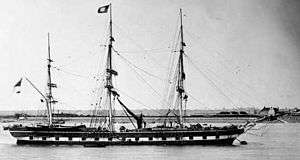HMS Hogue (1811)
 HMS Hogue, some time after her conversion to a screw ship | |
| History | |
|---|---|
| Name: | HMS Hogue |
| Ordered: | 1 October 1806 |
| Builder: | Deptford Dockyard |
| Laid down: | April 1808 |
| Launched: | 3 October 1811 |
| Fate: | Broken up, 1865 |
| General characteristics [1] | |
| Class and type: | Vengeur-class ship of the line |
| Tons burthen: | 1750 bm |
| Length: | 176 ft (54 m) (gundeck) |
| Beam: | 47 ft 6 in (14.48 m) |
| Depth of hold: | 21 ft (6.4 m) |
| Propulsion: | Sails |
| Sail plan: | Full rigged ship |
| Armament: |
|
HMS Hogue was a 74-gun third-rate ship of the line of the Royal Navy, launched on 3 October 1811 at Deptford.[1]
During the War of 1812, while under the command of Thomas Bladen Capel, HMS Hogue successfully trapped the American Privateer Young Teazer of the coast of Nova Scotia, Canada.
On 16 August 1813 Hogue captured the Portuguese ship Flor de Mar. At the time Tenedos was in sight.[Note 1]
From 7–8 April 1814, ships' boats of the Hogue, Endymion, Maidstone and Borer attacked Pettipague point.[3][4] In 1847 the Admiralty awarded the Naval General Service Medal with clasp "8 Apr Boat Service 1814" to all surviving claimants from the action.[5] The raid was commanded by Coote,[6] who was promoted as a result of the successful outcome, as was Lieutenant Pyne of the Hogue who assisted him.[7]
She was converted into a screw-propelled steamship frigate in 1850. Hogue was eventually broken up in 1865.[1]
Notes, citations, and references
- Notes
- Citations
- 1 2 3 Lavery, Ships of the Line vol.1, p188.
- ↑ The London Gazette: no. 17209. p. 88. 14 January 1817.
- ↑ James, p325
- ↑ Jerry Roberts. "The British raid on Essex". connecticuthistory.org. Retrieved 3 February 2014.
- ↑ The London Gazette: no. 20939. pp. 247–247. 26 January 1849.
- ↑ Wetherell, W.D. (2002). This American River: Five Centuries of Writing about the Connecticut. UPNE. pp. 56–59. ISBN 9781584651116.
Letter from Coote to Capel dated 9 April 1814
- ↑ Marshall, pp301-304
- References
- William James (naval historian) (2002) [1827]. The Naval History of Great Britain, Volume 6, 1811 – 1827 (Rev. ed.). London: Conway Maritime Press. ISBN 0-85177-910-7. OCLC 48836534.
- Lavery, Brian (2003) The Ship of the Line - Volume 1: The development of the battlefleet 1650-1850. Conway Maritime Press. ISBN 0-85177-252-8.
- Marshall, John (1833). Royal naval biography; or, Memoirs of the services of all the flag-officers, superannuated rear-admirals, retired captains, post-captains, and commanders, whose names appeared on the Admiralty list of sea-officers at the commencement of the year 1823, or who have since been promoted. Part 1. Volume 4. London: Longman, Rees, Orme, Brown and Green.